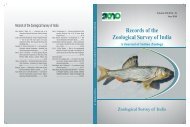Andaman booklet aw.FH10 - Zoological Survey of India
Andaman booklet aw.FH10 - Zoological Survey of India
Andaman booklet aw.FH10 - Zoological Survey of India
You also want an ePaper? Increase the reach of your titles
YUMPU automatically turns print PDFs into web optimized ePapers that Google loves.
Saddle Peak in North <strong>Andaman</strong> and 642 m at Mount Thulier in<br />
Great Nicobar Island. The precipitation is slightly higher in Nicobar<br />
with an average annual rainfall <strong>of</strong> 3000 to 3500 mm.<br />
History<br />
The <strong>Andaman</strong> and Nicobar groups <strong>of</strong> islands belong to a<br />
geosynclinals basin. The sediments <strong>of</strong> this region have gradually<br />
changed their characters, according to tectonic movements, to<br />
which they have been subjected to from time to time; as such the<br />
rocks are highly folded. The six distinct geological formations<br />
consisting <strong>of</strong> various groups <strong>of</strong> rocks, from these islands were<br />
reported. These formations include Older Sedimentaries, Ophiolite<br />
Suite, Mithakhari Group, <strong>Andaman</strong> Flysch, Archipelago series and<br />
the Rutland Shell-Limestone. They represent a period <strong>of</strong><br />
sedimentation, from Cretaceous (about 100 million years) to Sub-<br />
Recent (less than 10,000 years). The surface deposits <strong>of</strong> gravel beds<br />
and raised soil covers, on the other hand, are <strong>of</strong> very late origin,<br />
02
















